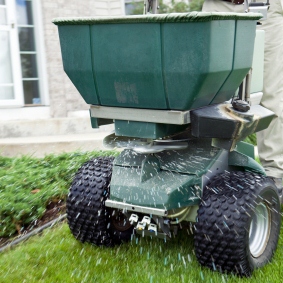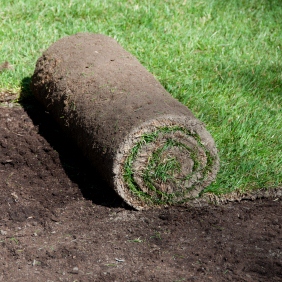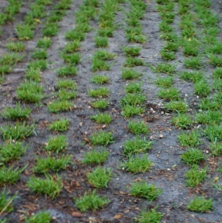Establishing Turfgrass: Seed vs. Sod
Planting a new lawn and establishing turfgrass begins with understanding your region's climatic conditions. The United States has five climatic zones: Cool and Humid, Cool and Arid, Warm and Arid, Warm and Humid, and a Transitional zone. All turfgrass types have the ability to grow in any zone for a portion of the year. Finding the most appropriate turfgrass type for your location will provide you with the best chances for a lush, green lawn. Once you have determined your climatic zone, the question now becomes seed vs. sod.

The National Turfgrass Evaluation Program (NTEP) is an excellent online source of information about which turfgrass types will grow well in your area. You can also consult with your local lawn and garden center or turfgrass experts at your local agricultural extension office to help determine the most appropriate type for your location. Common turfgrass types for cool season climates include Kentucky Bluegrass, Fine Fescue, Perennial Ryegrass, Tall Fescue, and Red Fescue. Common turfgrass types for the warm season climates include Bermuda Grass, St. Augustine Grass, Buffalo Grass, Zoysia Grass, and Bahia Grass.
Soil Preparation
Preparation of the soil prior to seeding or sodding is essential for a healthy lawn. The time and effort necessary to properly prepare the soil will depend on the size of the area and whether you are planting a new lawn or repairing an existing lawn. Preparations should include rough grading, tilling the soil to a depth of 2"-6", removing all debris, testing the soil pH and determining if corrective steps are needed, adding a layer of top soil, applying starter fertilizer, finish grading, and rolling the area lightly. Establishing healthy turfgrass requires that deliberate care be taken in preparation of the soil.
You can establish new turfgrass in two ways, seeding or sodding. Each has its advantages and disadvantages. The most apparent difference between the seeding and sodding is time. Sodded lawns offer immediate gratification, whereas seeded lawns take time to grow and mature.
Seed: Broadcast Seeding vs. Hydroseeding
Turfgrass seed can be applied in one of two ways, with a spreader or sprayer. Broadcast seeding utilizes a spreader to scatter seed over an area. Seed is then raked into the soil surface. Hydroseeding utilizes a tank and sprayer to apply a greenish-blue slurry of seed, mulch, and fertilizer over an area.

Broadcast Seeding Advantages: least expensive option; wide selection of turfgrass types available; minimal labor and time required; growth in difficult areas can be easier to establish; healthy root system develops during germination; and seed mixes are formulated for special requirements such as sun, shade, or both.
Broadcast Seeding Disadvantages: timing can be tricky and depends on your zone; rate of germination is slower; more water is needed to establish broadcast seed than hydroseed; seed can be blown away by wind, eaten by birds, and washed away by erosion; final result of the work may vary in quality; and lawn is unusable for a few weeks after seed has been spread.

Hydroseeding Advantages: less expensive than sod; can be accomplished in a short time; assists with erosion control; rate of germination is quicker; less water is necessary to establish hydroseed than either broadcast seed or sod; and healthy root system develops during germination.
Hydroseeding Disadvantages: timing can be tricky and depends on your zone; more expensive than broadcast seed; not a DIY option and requires a professional application; limited turfgrass types available; final result of the work may vary in quality; and lawn is unusable for a few weeks after seed has been applied.
Sod: Rolls of Sod vs. Plugs of Sod
Sod is a turfgrass that has been established by a sod farm. Purchased locally, types of sod may include rolls or plugs. Rolls of sod are purchased and delivered to your property on pallets. The rolls of sod are then laid over the soil, with strips tucked together and then rolled flat with a weighted roller. Plugs of sod are common with warm-season grasses. They are purchased by the bushel or torn from strips of sod. Plugs are planted in the soil in rows apart from one another, and over time they grow and fill in the barren areas.

Rolls of Sod Advantages: instant lawn, available for use sooner than a seeded lawn; immediate erosion control; can be applied anytime the ground is not frozen; the quality of the product is immediately visible.
Rolls of Sod Disadvantages: most expensive option; labor-intensive; requires more watering than broadcast seed or hydroseeding; a vibrant and healthy root system takes more time to develop than with other methods; lawn is unavailable for use for a few weeks after sod has been laid.

Plugs of Sod Advantages: less expensive than rolls of sod or hydroseed; the quality of the product is immediately visible; a healthy root system develops during the spread of growth.
Plugs of Sod Disadvantages: timing can be tricky and depends on your zone; time-consuming; lawn takes considerable time to fill in, as compared to other options; weeds and animals can disturb plant growth.
Should you seed or should you lay sod? Given the advantages and disadvantages of all the methods, it depends. You might choose sod because your lawn needs immediate erosion control. You might choose seed because your lawn has difficult areas in which to grow turfgrass. It's also quite possible to use a combination of the methods to ensure that your lawn is properly covered with healthy turfgrass for years to come. Maintenance aside, selecting seed or sod depends on your expectations, your budgetary limits, the conditions of your property, and the local climate.

Jeff Calcamuggio
Jeff is an Editor-at-Large for Buildipedia.com who writes and edits Featured At Home and Knowledgebase content. Prior to joining Buildipedia, Jeff's work experience included carpentry, construction documentation, specification writing, construction administration, project management, and real estate property inspection. Jeff is a member of the Construction Specifications Institute (CSI) and an educator at Columbus State Community College and enjoys challenging DIY home improvement projects.
†

